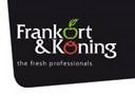In recent weeks, the Dutch soft fruit market has been characterized by strawberry, raspberry, and blackberry price fluctuations. The redcurrant market is far more stable, and blueberry prices, though falling, are still high. Sjraar Hulsman, Business Development Manager at Frankort&Koning, gives an overview of the market situation.
Fall cultivation is done
"The strawberry season could be considered quite unusual, entirely different from last year," Sjraar begins. "For example, the fall cultivation under glass, set in mid-August, was done early. That led to huge market volumes in September and the first week of October. Those volumes have since plummeted. I estimate last week's Dutch and Belgian crop was less than a third of that week's volume in previous years."
 Sjraar says there are two reasons for that. Firstly, tray plants went into cold stores (too) late and suffered frost damage last year.
Sjraar says there are two reasons for that. Firstly, tray plants went into cold stores (too) late and suffered frost damage last year.
Some growers, thus, culled and replanted or had plants that produced poorly. Secondly, it was scorching in September.
That brought production forward two to three weeks. "Normal fall yields are between 4.5 and 5 kg/m2. But you're lucky if you get above four kilograms now," Sjraar reckons.
"This situation significantly affected prices. The United Kingdom and Scandinavia had plenty of local production until the second week of October. That put considerable pressure on strawberry prices until that week. Auction prices were around €3/kg for large batches; in 2022, that was between €6 and €7. From the second of October, the tide turned. There are continuous market shortages and auction prices rose from €5 in week 42 to between €11.50 and €12.50 last week."
The Netherlands and Belgium are the sole European market suppliers
According to Hulsman, in November, there is still demand for strawberries. "What plays into that is that in October and November, the Netherlands and Belgium are the European market's sole suppliers. From the end of next week, we expect the first production from Egypt. That often means the commercial volumes arrive a week later," he says.
"It's uncertain how the Spanish and Moroccan season will go. Growers planted later, and storms have delayed setting up some tunnels. Spain will have a challenging season because of the limited availability of water. The rainy season is starting, and hopefully, enough will fall for growers to maintain production. But, in the long run, Spanish growers will have to switch to cultivation systems that use less water per kilo."
Dutch lit strawberry cultivation will begin in week 48, and Frankort&Koning has again expanded its production of this cultivation. "There's interest among our customer base to continue longer with Dutch products. Next season, the lit cultivation area will be larger again now that many growers have replaced their son-t lights with energy-efficient LED lighting. So, while gas prices aren't yet at pre-energy crisis levels, they're at levels that make economically viable cultivation possible again," Sjaar explains.

"We grow mostly the Sonata and Sonsation varieties under lights. Other varieties are being tested, but they aren't yet widely available. We encourage our growers to package directly on their farms in sealed packages. That extends the strawberries' display life and lowers chain costs. We do that in the lit crop so we can deliver the produce from the grower to the customer as fresh as possible."
"The Dutch greenhouse raspberry season was genuinely difficult. In late September/early October, production peaked, leading to disappointing prices. On average, those prices were between €6.50 and €7/kg. Since week 41, prices recovered to roughly €11 to €14. The delayed Spanish and Moroccan production is certainly to blame," Sjaar declares.
Flavor varieties
"The blueberry shortage on the market is well-known by now. After last year's mild winter, many varieties didn't get the cold temperatures they needed. Peruvian berries are sold for hefty prices of €13 to 15/kilo. That's since dropped back to €10/kg, which is still high compared to previous years."
"In Peru, growers have been planting plenty of flavorful, new varieties, but those will only come onto the market in large volumes from 2025 onwards. However, even with these varieties, the way the berries are picked remains viral. Even with these flavored varieties, the packs still sometimes have too many soft berries. That's totally unacceptable," Sjaar exclaims.
"Redcurrant sales are very stable. That price has been at approximately €8 for a long time. These sales usually slow down in November, but I don't foresee a dip for the next few weeks. Prices may pick up slightly as the holidays approach. Last but not least, the blackberry market is particularly erratic."
"That's somewhat inherent to that market. There's either too much or too little. You can't take real action to prevent a price drop. In weeks 37/38, average prices were above €20 per kilogram; that dropped to €12 in early October and has been around €20 again since last week," the manager says.
"Our company has been making good headway with soft fruit, and we are experiencing steady growth. That's possible because we're a reliable, flexible partner for growers and retailers. We take maximum advantage of our broad European network's strength. With abundant supply, we can easily interest many markets in the Dutch product."
"If the market's tight, with sky-high prices, we switch, in consultation with growers and clients, to smaller content per package. For instance, the 125g pack of blueberries has been back recently, and 500g packs have been reorganized for many buyers. The great thing is that there are always new satisfied customers left who we can also supply with soft fruit the next year," Sjaar concludes.
 For more information:
For more information:
Sjraar Hulsman
Frankort & Koning
Tel: + 31 (0) 773 897 328
Email: [email protected]
www.frankort.nl
